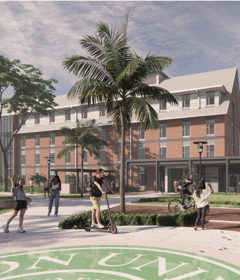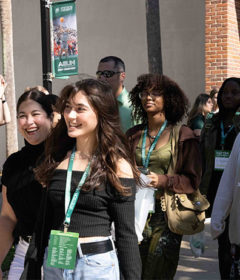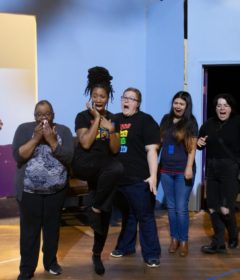The Therapy of Play
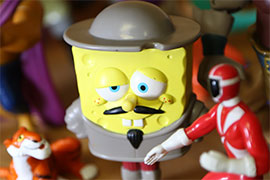
Editor’s note: This article appears in the Spring issue of Stetson University Magazine, now available online.

Bart Simpson, Scooby-Doo, the Powerpuff Girls, SpongeBob SquarePants, Bugs Bunny and other cartoon characters are teaching Stetson graduate students the power of play.
“Play is the first language children learn,” said Gloria Lopez, a Clinical Mental Health Counseling graduate student who also is earning certificates in play therapy and school counseling. “A lot of people outside the clinical realm might see therapy as just sitting down in that empty chair and saying, ‘Tell me how you feel’ to a client. Play therapy is working with your unconscious and expressing yourself through more than just talking.”
That’s where those cartoon characters — or, rather, miniature plastic figures of them and many others — come into play.
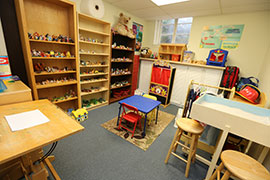
Venture into the Department of Counselor Education’s play-therapy room at Flagler Hall and you step into a child’s paradise stuffed with Buzz Lightyear, Clifford the Big Red Dog, My Little Pony, Mr. Potato Head and Hot Wheels, along with teddy bears, a sand tray (tabletop sandbox), plastic toy people, soldiers, dogs, horses, dinosaurs and more.
Some spooky stuff lurks in the play-therapy room, too: plastic skulls, skeletons, snakes, a creepy witch and even a miniature black casket with the white block letters RIP.
Lopez and the 11 other students in the play-therapy program are getting real-world, hands-on experience bringing characters to life for children in need through service learning. Meanwhile, the Counselor Education graduate program is very real — with the blessing of the Council for Accreditation of Counseling and Related Educational Programs, which accredits master’s and doctoral degree programs in counseling and its specialties offered by colleges and universities in the United States and throughout the world. Stetson’s Counselor Education graduate students can specialize in either Clinical Mental Health Counseling or Marriage, Couple and Family Counseling. Regardless of program choice, students are guaranteed a highly experiential-learning environment.
The Play Therapy Certificate Program service learning lab is a prime example. Under faculty supervision, the Stetson play-therapy students work at various locations of Head Start in Volusia County. A program of the U.S. Department of Health and Human Services, Head Start provides early-childhood education, health, nutrition and parent involvement services to low-income children and their families.
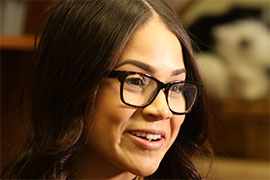
The goal of the students’ work, simply, is to create positive mental, social and/or behavioral change.
“We create a treatment plan that is solely based on the child’s individual needs,” Lopez explained. “Children will present their needs, wants, wishes and fears, but we sometimes have to listen in unconventional ways to truly understand them. Through playful interactions, we are allowing the child to process their situation and learn new ways of coping.”
And, yes, the strategies work.
“The first time I bring in miniatures to new students, they’ll look at them and say, ‘They’re toys,’” laughed Page Thanasiu, Ph.D., assistant professor of counselor education and a Registered Play Therapist- Supervisor. “Or, they’ll look at me skeptically and say, ‘Really?’
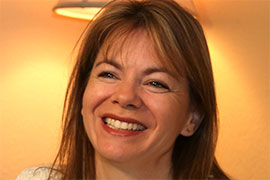
“We have students in our program up through their 60s, so they’re thinking, ‘Hmmm, that’s not for me.’ And I say, ‘Give it a try,’ and we do an experiential activity. Usually from that point on, the majority of students say, ‘I don’t know what just happened, but I want to learn how to do that.’”
Students in the program learn “that there are numerous ways we communicate that aren’t verbal,” added Thanasiu, noting that the program also teaches another nonverbal method known as expressive arts interventions.
“These can be incredibly powerful ways to communicate things that are meaningful to a person. Our students learn not just how to do it but the why behind it, and it’s important that they personally experience the interventions, too.”
“With adults, you can sit down and find some resolution by talking things through,” Thanasiu continued. “Because of their stage of brain development, children don’t heal by talking about their problems; it’s not how the brain works early on. Play is the child’s first language. They communicate, learn and grow by doing. So, you can communicate with them through that play and learn about their inner worlds and the workings of their minds by understanding their play.”
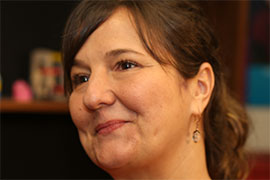
FOR GROWN-UPS, TOO
“Play therapy isn’t just for kids,” asserted Melissa Basso, a graduate student in Marriage, Couple and Family Counseling. “When I tell people that I’m working on the play-therapy certificate, the first thing they immediately say is, ‘Oh, you want to work with kids.’ I say, ‘Well, not necessarily.’ All of us have a kid inside of us, and accessing it through some of the play-therapy techniques and interventions sort of accesses the kid in everyone.”
Thanasiu taught and supervised the hands-on lab at Head Start for the first two years after founding the play therapy program at Stetson in 2014. Soni McCarty, a Longwood-based licensed clinician, currently heads the lab. McCarty meets with two Head Start behavioral specialists to identify children in need and the severity of the need.
Stetson students are introduced into the process incrementally.
“When I was supervising the lab, we had a child who had been severely sexually traumatized. So, I took that client as my own because of my levels of training and experience,” Thanasiu stated as an example. “I would not have had one of the students who was just starting to practice do that, even though they have a very strong basic set of skills at that point.”
Students work with children who may be facing “a lack of structure at home or a variety of adverse experiences that have left them struggling with some very intense emotions,” Thanasiu said.
Essentially, for the graduate students it’s all about learning by doing.
“We’ll cover the theoretical aspect in class, and students have textbook reading to complete. I show videos of myself working with children to demonstrate what the process looks like,” Thanasiu said.
“Before they get a chance to work with children, I pair students up, provide them with toys and say, ‘You’re the child, and you’re the therapist.’ They practice that modality for at least five weeks prior to working directly with children.”
Students’ sessions with the Head Start children are videoed for later study, with McCarty watching from a separate room along with the other students.
The students are believers.
“I saw a small quiet introverted child come out of her shell in her own way, and in her own time,” Basso said. “I saw a vivacious outgoing powerful little girl find a way to be strong without intimidating others. I saw a little boy dealing with the arrival of a new baby in his home learn to adapt to the changes that were happening.”
Said Lopez: “Using the play-therapy modality and having that child trust in me while we’re playing and actually listen was like, ‘Oh my gosh, this works! I’m really doing it!’”
-Rick de Yampert

